| Listing 1 - 10 of 27 | << page >> |
Sort by
|
Book
Year: 1965 Publisher: Oxford: Pergamon,
Abstract | Keywords | Export | Availability | Bookmark
 Loading...
Loading...Choose an application
- Reference Manager
- EndNote
- RefWorks (Direct export to RefWorks)
Book
Year: 1929 Publisher: New York: Ronald press,
Abstract | Keywords | Export | Availability | Bookmark
 Loading...
Loading...Choose an application
- Reference Manager
- EndNote
- RefWorks (Direct export to RefWorks)
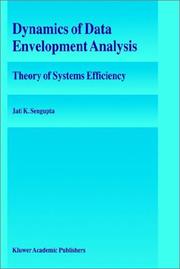
ISBN: 9780792335818 0792335813 Year: 1995 Publisher: Dordrecht: Kluwer,
Abstract | Keywords | Export | Availability | Bookmark
 Loading...
Loading...Choose an application
- Reference Manager
- EndNote
- RefWorks (Direct export to RefWorks)
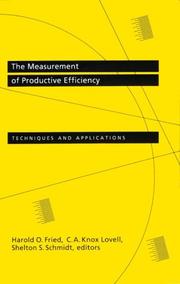
ISBN: 0195072189 1423737512 0195361105 1280441267 1601298501 9781423737513 9780195072181 9781280441264 9786610441266 661044126X 0197710409 Year: 1993 Publisher: New York (N.Y.) : Oxford university press,
Abstract | Keywords | Export | Availability | Bookmark
 Loading...
Loading...Choose an application
- Reference Manager
- EndNote
- RefWorks (Direct export to RefWorks)
This work focuses on the measurement and explanation of producer performance. The contributors view performance as a function of the state of technology and economic efficiency. They explore ways to construct production frontiers and levels of efficiency.
Economic production --- Business policy --- Efficiency, industrial --- Industrial productivity --- Économie --- --Efficacité --- Measurement --- 1527 --- 658.51 --- Industrial efficiency --- -Industrial productivity --- -Productivity, Industrial --- TFP (Total factor productivity) --- Total factor productivity --- Production (Economic theory) --- Efficiency, Industrial --- Industrial management --- Organization of production --- Measurement. --- -Organization of production --- 658.51 Organization of production --- -658.51 Organization of production --- Productivity, Industrial --- Production --- Econometrics --- E-books --- --Measurement --- Efficiency, industrial - Measurement --- Industrial productivity - Measurement --- Efficacité
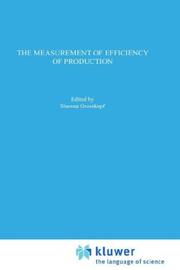
ISBN: 089838155X 9048158133 9401577218 9780898381559 Year: 1985 Publisher: Boston: Kluwer-Nijhoff,
Abstract | Keywords | Export | Availability | Bookmark
 Loading...
Loading...Choose an application
- Reference Manager
- EndNote
- RefWorks (Direct export to RefWorks)
Economic production --- Production (Economic theory) --- Industrial efficiency --- #SBIB:35H202 --- #SBIB:014.IO --- Microeconomics --- Supply and demand --- Demand (Economic theory) --- Supply-side economics --- Efficiency, Industrial --- Industrial management --- Overheidsmanagement: prestatiemanagement
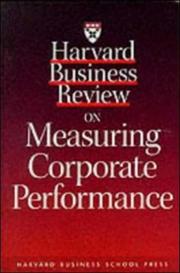
ISBN: 0875848826 9780875848822 Year: 1998 Publisher: Boston (MA): Harvard Business School Press,
Abstract | Keywords | Export | Availability | Bookmark
 Loading...
Loading...Choose an application
- Reference Manager
- EndNote
- RefWorks (Direct export to RefWorks)
Business policy --- Industrial productivity --- -Industrial efficiency --- -Organizational effectiveness --- -658.4013 --- Management --- Organization --- Efficiency, Industrial --- Industrial management --- Productivity, Industrial --- TFP (Total factor productivity) --- Total factor productivity --- Industrial efficiency --- Production (Economic theory) --- Measurement --- Organizational effectiveness --- Measurement. --- 658.4013 --- Analyse financière --- Entreprise performante
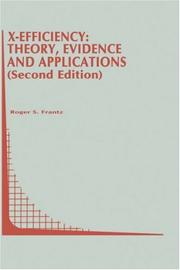
ISBN: 0792397681 1461378753 1461562651 9780792397687 Year: 1997 Volume: 23 Publisher: Boston (Mass.) : Kluwer academic,
Abstract | Keywords | Export | Availability | Bookmark
 Loading...
Loading...Choose an application
- Reference Manager
- EndNote
- RefWorks (Direct export to RefWorks)
My interest in X-Efficiency (XE) dates back to 1978. At the time, I was writing the dissertation for my Ph. D. at Washington State University. My dissertation was concerned with the role of attitudes in the school-to-work transition among young men. I was advised by Professor Millard Hastay (a member of my committee) to look at Leibenstein's "new" book, Beyond Economic Man. One of the things that caught my attention was his behavioral description of (selective) rationality. It seemed that Leibenstein' s behavioral description of a (selectively) rational individ ual was very similar to what psychologists such as Abraham Maslow were reporting as being the product of a particular motivational system. In other words, I was impressed with the idea that what Leibenstein was referring to as X-inefficiency was being discussed by psychologists as "the way it (often) is. " So from the beginning I always considered the concept ofX-(in)efficiency to be a valuable one for understanding human behavior. I have since come to believe that this is particularly true when considering behavior in non-market environments, i. e. , within the firm. Work on this book, however, can most realistically said to have started with work which I began in 1982 while I was a Visiting Scholar at Harvard University. Professor Leibenstein suggested that I consider how some empirical evidence which was being cited as evidence for the role of property rights might also be consistent with XE theory. (The consistency, in both directions, is considerable.
Industrial efficiency --- Industrial productivity. --- Industrial policy. --- Efficience dans l'industrie --- Productivité --- Politique industrielle --- Industrial efficiency. --- Industrial policy --- Productivité --- Microeconomics. --- Industrial organization. --- Industrial Organization. --- Industries --- Organization --- Industrial concentration --- Industrial management --- Industrial sociology --- Price theory --- Economics --- Industrial productivity --- Efficiency, Industrial
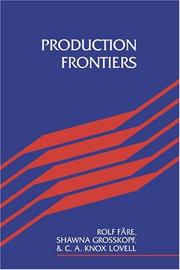
ISBN: 0521420334 0521072069 0511551711 9780521420334 9780511551710 9780521072069 Year: 1994 Publisher: Cambridge: Cambridge university press,
Abstract | Keywords | Export | Availability | Bookmark
 Loading...
Loading...Choose an application
- Reference Manager
- EndNote
- RefWorks (Direct export to RefWorks)
This book presents a mathematical programming approach to the analysis of production frontiers and efficiency measurement. The authors construct a variety of production frontiers, and by measuring distances to them are able to develop a model of efficient producer behaviour and a taxonomy of possible types of departure from efficiency in various environments. Linear programming is used as an analytical and computational technique in order to accomplish this. The approach developed is then applied to modelling producer behaviour. By focusing on the empirical relevance of production frontiers and distances to them, and applying linear programming techniques to artificial data to illustrate the type of information they can generate, this book provides a unique study in applied production analysis. It will be of interest to scholars and students of economics and operations research, and analysts in business and government.
Production possibility curve. --- Industrial efficiency. --- Efficience dans l'industrie. --- Economic production --- Production (Economic theory) --- Business, Economy and Management --- Economics --- Efficiency, Industrial --- Industrial management --- Production frontier --- Transformation curve --- THEORIE ECONOMIQUE --- EFFICACITE PRODUCTIVE --- THEORIE DE LA PRODUCTION
Book
ISBN: 9781139565981 9781107036161 9781107687653 1108654169 1139565982 1108627153 110703616X 1107687659 9781108627153 9781108654166 Year: 2019 Publisher: Cambridge: Cambridge University Press,
Abstract | Keywords | Export | Availability | Bookmark
 Loading...
Loading...Choose an application
- Reference Manager
- EndNote
- RefWorks (Direct export to RefWorks)
Methods and perspectives to model and measure productivity and efficiency have made a number of important advances in the last decade. Using the standard and innovative formulations of the theory and practice of efficiency and productivity measurement, Robin C. Sickles and Valentin Zelenyuk provide a comprehensive approach to productivity and efficiency analysis, covering its theoretical underpinnings and its empirical implementation, paying particular attention to the implications of neoclassical economic theory. A distinct feature of the book is that it presents a wide array of theoretical and empirical methods utilized by researchers and practitioners who study productivity issues. An accompanying website includes methods, programming codes that can be used with widely available software like MATLAB® and R, and test data for many of the productivity and efficiency estimators discussed in the book. It will be valuable to upper-level undergraduates, graduate students, and professionals.
Labor productivity --- Industrial efficiency --- Performance --- Efficiency, Industrial --- Industrial management --- Labor output --- Productivity of labor --- Industrial productivity --- Capital productivity --- Hours of labor --- Labor time --- Productivity bargaining --- Measurement. --- Measurement --- Mathematical models. --- Management. --- Performance technology
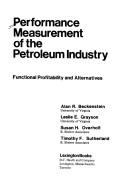
ISBN: 0669030171 9780669030174 Year: 1979 Publisher: Lexington (Mass.): Lexington books,
Abstract | Keywords | Export | Availability | Bookmark
 Loading...
Loading...Choose an application
- Reference Manager
- EndNote
- RefWorks (Direct export to RefWorks)
Petroleum industry and trade --- Industrial efficiency --- 665.6 --- 658.155 --- -Energy industries --- Oil industries --- Efficiency, Industrial --- Industrial management --- Mineral oil technology. Technology of petroleum and allied products --- Profit. Loss. Earning power. Trends in profitability. Yield. Trading profit, return --- -Mineral oil technology. Technology of petroleum and allied products --- 658.155 Profit. Loss. Earning power. Trends in profitability. Yield. Trading profit, return --- 665.6 Mineral oil technology. Technology of petroleum and allied products --- -Efficiency, Industrial --- Petroleum industry and trade - United States
| Listing 1 - 10 of 27 | << page >> |
Sort by
|

 Search
Search Feedback
Feedback About UniCat
About UniCat  Help
Help News
News